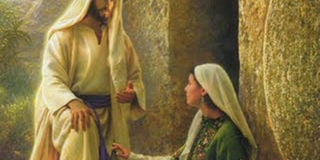Prime
Was Jesus Christ really married? Is it possible?

An image of Jesus and Mary Magdalene. An ancient document suggests that the two were married. Internet Photo.
What you need to know:
On September 23, Sunday Monitor published an article “Jesus was married, says ancient document”. Allow me to respond to this highly sensitive article.
A response from Vatican on this article appeared in Sunday Vision. The Vatican challenged the authenticity of the fragment of the ancient papyrus.
“Do not be Afraid” were the words of the angel and Jesus used to the women who were looking for him after his resurrection (Matt. 28:5-10). Jesus again used them when his disciples were terrified seeing him walk on the lake (Matt. 14: 26).
Keeping the values intact
We read from the Bible that even when Jesus was still on earth, there was much opposition to him, anti-Christ elements which resulted into his death. In an environment of opposition, mixed feelings, uncertainty and hatred. It is logical to believe that there are many different versions of birth, life and death of Jesus. Many writers wrote false accounts of Jesus. These false accounts or false gospels were challenged by the Catholic Church as the custodian of Christian Faith to “end of time” (Matt. 28: 20). Even in our time today, no association will allow others to dilute their values without challenge.
“In the beginning was the Word, and the Word was with God, and the Word was God...The Word became flesh and made his dwelling among us...” (John 1: 1-18). This is what the church calls “Incarnation”. Jesus Christ is true God and true man. The first clear message that Jesus was God, was after his resurrection when Thomas, one of the Twelve, called him “My Lord and my God” after Jesus showed him his pierced hands and side (John 20:28). “My Lord” he was addressing the human nature and “My God” the divine nature. During the great commissioning of the Apostles (Matt. 28: 17), “When they saw him, they worshiped him,..”. We only worship God.
During the first centuries, the Church as the custodian of Christian Faith had to defend and clarify this truth of faith against the heresies that falsified it, such as that of Gnostic Docetism, which this article quotes. The first ecumenical council of Nicaea in AD 325 confessed in its Creed that the Son of God is “begotten, not made, of the same substance as the Father”. It condemned Arius (Arianism) which taught that the Son of God had a beginning and was a created being. This heresy threatened to divide the Christian Church. St. Cyril of Jerusalem (AD 315 – 386) for instance, instructed his faithful, “If ever you are sojourning in cities, inquire not simply where the Lord’s House is (for the other sects of the profane also attempt to call their own dens ‘houses of the Lord’), nor merely where the church is but where is the Catholic Church…(Catechetical Lecture, xviii, 26). Flavious Theodosius (AD 347- 395) was a Roman Emperor who entered the term Catholic Christian into Imperial Roman Law. He reserved that name from adherents of “that religion which was delivered to the Romans by the divine Apostle Peter, as it has been preserved by faithful tradition…as for the others, since in our judgment they are foolish madmen, we decree that they shall be branded with the ignominious name of heretic…”.
Flooding of false doctrines
The fragment of ancient papyrus being quoted in the article is by no means authentic. During the second half of the fourth century AD, according to the Nag Hammadi, other gospels were written. These include the gospel of the Twelve (AD 200), the gospel according to the Egyptians (AD 150), the Gospel of Peter (AD 140), the Gospel of Mathias (AD 125), the acts of Peter (AD 165). Other people took up the writings of these false gospels. Take for instance, the Acts of Peter, which was written in AD 165 but Peter had died in AD 67. We must admit that there was a lot of confusion among the different sects at the early Church; what Christ himself prophesied.
We have confidence in the Catholic Church because of the promises Jesus made. During The Great Commission, Matt. 28:16-20, “All authority in heaven and earth has been given to me…go and make disciples of all nations, baptizing them in the name of the Father, Son, Holy Spirit, teach them to obey. And surely I am with you always, to the very end of the age.”
Christ built his Church on Peter (Rock). Peter was a name given to Simon, son of John, by Jesus as we find in John 1:42, “Jesus looked at him and said, ‘You are Simon son of John. You will be called Cephas’ (which, when translated, is Peter)”. In Matt. 16: 13-19, “…And I tell you that you are Peter, and upon this rock I will build my Church, and the gates of Hades will not overcome it. I will give you the keys...” Jesus singled Peter out and told him “Feed my sheep, take care of my sheep”, John 21: 15-17.
Even in the Acts, Peter gave lead to the rest: he over saw the election of Matthias to replace Judas who betrayed Jesus (Acts 1:12-26); he addressed the crowd to explain about the crucified Jesus of Nazareth (Acts 2:14-41); he performed the first miracle of healing the crippled begger (Acts 3: 1-11). Peter was recognised by his colleagues as their leader: the disciple Jesus loved could not enter the grave of Jesus before Peter (John 20:308)
“Do not be afraid”. Jesus was not an ordinary person and he proved his divinity and humanity beyond doubt. Therefore, he could not have married. Christians are taught not to revenge: In 1Peter 3: 9- 10, “Do not reply evil with evil or insult with insult, but with a blessing, because to this you were called so that you may inherit a blessing”




